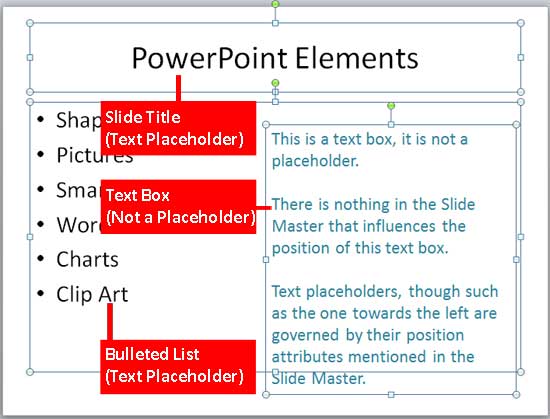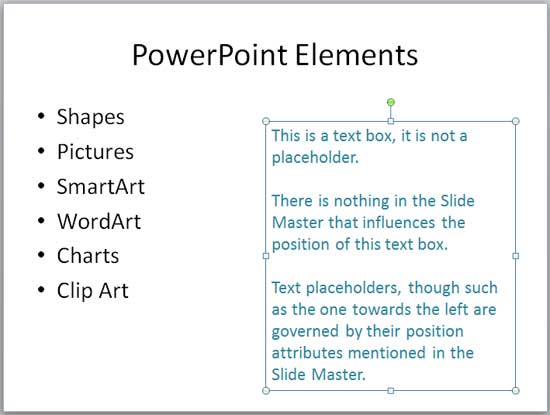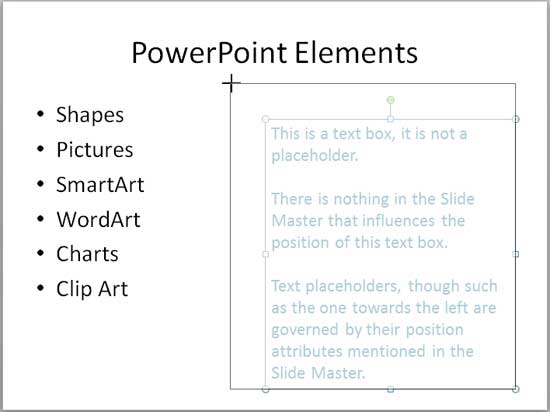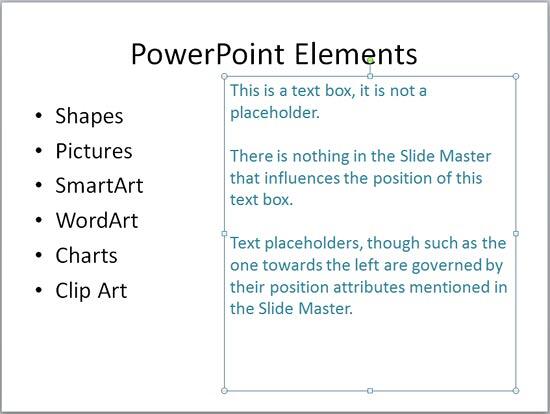Text boxes in PowerPoint need to be moved and resized within different areas of the slide. While you may think that selecting and resizing is all
that is to be done, that's not the entire truth because there's so much more you can do even with mere resizing, if you know that these options
exist! In a previous tutorial, you learnt how to
move text boxes on a slide. As suggested in that
tutorial, you should only resize text boxes, and not text placeholders on the slide since the size of the latter in the text placeholder is normally
controlled by the Slide Master.
Tip: Typically text placeholders for
regular text content or even slide titles are located in the same position on successive slides. So, if you really do need to resize a text
placeholder, do it within the Slide Master not only to provide a consistent look to your presentation, but also to prevent yourself from monotonous
job of resizing text placeholders on each and every slide. Don't know the difference between a text box and a text placeholder? Look at our
Text Boxes vs. Text Placeholders tutorial.
Now that you are more aware of why you should not resize the text placeholders, let me tell you that all techniques on this page apply to both
text placeholders and text boxes. Actually, they also apply to any shapes in your slides that contain text. Learn more about how you can resize
your text boxes in PowerPoint 2010 for Windows:
- Open any slide which has a text box, as shown in Figure 1. Note that out of the three text containers on this slide, only one of
them is a text box, and that's the one on the right side of the slide (which includes blue colored text).
-

Figure 1: Slide with all text containers selected
-
Click on the edge of the text box so that it shows a solid line with selection handles on its perimeter (see Figure 2).
-

Figure 2: Text box selected
-
Tip: If you click within the text box, you'll see a dotted line surrounding the perimeter of the text box indicating that you are
editing the text inside the box. A solid line indicated that the entire text box is selected rather than just the individual text within it.
-
The selected text box now also shows the several handles, as shown in Figure 3 (highlighted in red). These handles are
explained below:
-
Four blueish white handles on the corners (see Figure 3): These are round shaped and are on the corners of the text box.
-
Four blueish white handles on the sides (see Figure 3): These are square shaped and placed at the midpoint of each border on
the text box.
-

Figure 3: Text box with transform points
-
Note that if you have selected the Resize shape to fit text option as explained in our
Text Box Autofit Options in PowerPoint 2010 tutorial, you
may not be able to resize the text boxes as you wish. It is possible only when you have selected the Do not Autofit option. So,
first select the Do not Autofit option and then you will be able to resize the text box using these eight square handles as
explained below:
- Drag any of the handles inwards, and you reduce the size of the text box.
- Drag any of the handles outwards, and you increase the size of the text box.
- To maintain the width:height proportion of the text box, hold the Shift key while you drag one of
the four corner handles. The Shift key does nothing to the four side handles.
- To resize equally on opposite sides of a text box, press the Ctrl key while you drag one of the
four side handles.
- To resize equally from the center on all four sides of a text box, press the Ctrl key while you
drag one of the four corner handles.
-
In Figure 4 you can see that the selected text box is being resized by dragging one of the corner handles.
-

Figure 4: Text box being resized
Tip: Resizing your text box is changing the position of your text box? You need to
control Autofit Options for the particular Text Box or
Placeholder you are resizing.
-
Figure 5 shows the selected text box is resized. Compare it to Figure 2 above.
-

Figure 5: Text box is resized
-
Make sure to save your presentation often.








